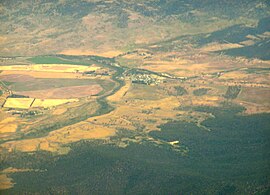| Avoca Tasmania | |||||||||||||||
|---|---|---|---|---|---|---|---|---|---|---|---|---|---|---|---|
 Aerial photo of the region from the east | |||||||||||||||
| Coordinates | 41°46′53″S 147°43′19″E / 41.78139°S 147.72194°E | ||||||||||||||
| Population | 192 (SAL 2021)[1] | ||||||||||||||
| Postcode(s) | 7213 | ||||||||||||||
| Location |
| ||||||||||||||
| LGA(s) | Northern Midlands, Break O'Day | ||||||||||||||
| Region | Central, North-east | ||||||||||||||
| State electorate(s) | Lyons | ||||||||||||||
| Federal division(s) | Lyons | ||||||||||||||
| |||||||||||||||
Avoca is a rural locality in the local government areas (LGA) of Northern Midlands (99%) and Break O'Day (1%) in the Central and North-east LGA regions of Tasmania. The locality is about 69 kilometres (43 mi) south-east of the town of Longford. The 2021 census recorded a population of 192 for Avoca.
It is a small village located 81 kilometres (50 mi) south-east of Launceston in Tasmania.
Avoca is situated on the banks of the South Esk River near the confluence of the St. Paul's river in the parish of Avoca and county of Cornwall, and was first settled in the 1830s. It was originally named St. Paul's Plains by John Helder Wedge during a 1833 survey of the area.[2] The area was officially settled in 1834 as a farming, coal and tin mining village.
- ^ Australian Bureau of Statistics (28 June 2022). "Avoca (Tas.) (suburb and locality)". Australian Census 2021 QuickStats. Retrieved 28 June 2022.
- ^ "Avoca, Tasmania: Travel guide and things to do". Traveller. 11 December 2014.
